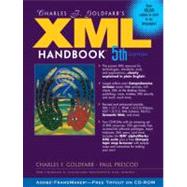
| Goldfarb's XML Handbook | |
| Preface | |
| Goldfarb | |
| Foreword | |
| co-editor of W3C XML Recommendation | |
| Prolog | |
| chair of W3C XML Working Group | |
| The Who, What, And Why Of Xml | |
| Why XML? Introductory Discussion | |
| Text Formatters and SGML | |
| XML Markup | |
| Road to XML | |
| EDI, EAI and Other TLAs | |
| Conclusion | |
| Just Enough XML | |
| Introductory Discussion | |
| The Goal | |
| Elements: The Logical Structure | |
| Unicode: The Character Set | |
| Entities: The Physical Structure | |
| Markup | |
| Document Types and Schemas | |
| Well-Formedness and Validity | |
| Namespaces | |
| Hyperlinking | |
| Stylesheets | |
| Conclusion | |
| The XML Usage Spectrum | |
| Introductory Discussion | |
| Is XML for Documents or for Data? A Wide Spectrum of Application Opportunities | |
| Opposites Are Attracted | |
| MOM and POP - They're So Great Together! Conclusion | |
| XML for People | |
| Introductory Discussion | |
| Beyond HTML | |
| Database Publishing | |
| Graphics and Multimedia | |
| XML-Based Forms | |
| Semantic Web | |
| Personalized Information Delivery | |
| Alternative Delivery Platforms | |
| Office Suites | |
| Conclusion | |
| XML for Machines | |
| Introductory Discussion | |
| Integrated Electronic Commerce (IEC) | |
| Vertical Applications | |
| Repository Stories | |
| Web Services | |
| Conclusion | |
| Secrets of the XML Programmers | |
| Introductory Discussion | |
| Object-Oriented | |
| Parsing | |
| APIs | |
| Protocols | |
| Conclusion | |
| XML Jargon Demystifier" Introductory Discussion | |
| Structured vs Unstructured | |
| Tag vs Element | |
| Content | |
| Document Type, DTD, and Markup Declarations | |
| Schema and Schema Definition | |
| Document, XML Document, and Instance | |
| What's the Meta? Notations and Characters | |
| Coding, Encoding, and Markup | |
| URL and URN and URI and URI Reference | |
| Documents and Data | |
| And in Conclusion | |
| Three-Tier Applications | |
| Personalized Frequent-Flyer Website | |
| Introductory Discussion | |
| Client/Server Frequent-Flyer Sites | |
| What's Wrong with This Web Model? A Better Model for Doing Business on the Web | |
| An XML-Enabled Frequent-Flyer Website | |
| Understanding the Softland Air Scenario | |
| Towards the Brave New Web | |
| Building an Online Auction Website | |
| Application Discussion | |
| Getting Data from the Middle Tier | |
| Building the User Interface | |
| Updating the Data Source from the Client | |
| Conclusion | |
| Enabling Data Sources for XML | |
| Case Study | |
| XML Data Sources | |
| InetPurchasing.Com | |
| Conclusion | |
| E-Commerce | |
| From EDI to IEC: The New Web Commerce | |
| Introductory Discussion | |
| What is EDI? The Value of EDI | |
| Traditional EDI: Built on Outdated Principles | |
| Leveraging XML and the Internet | |
| Conclusion | |
| XML and EDI: Working Together | |
| Introductory Discussion | |
| What is Integrated E-commerce? Traditional EDI and XML Compared | |
| An XML-EDI Trading System | |
| The Future of E-commerce | |
| Integration | |
| Application Integration with Web and Email | |
| Case Study | |
| Legacy Applications | |
| Enterprise Application Integration (EAI) | |
| Subject Software Company | |
| The Challenge | |
| The Solution | |
| Business Integration | |
| Application Discussion | |
| Integration Domains | |
| The Business Integration Stack | |
| Deploying Business Integration | |
| Conclusion | |
| Content Management | |
| "World" Class Content Management | |
| Case Study | |
| Auto Manufacturing Is Large-Scale Publishing | |
| Global Markets, Global Information | |
| Needed: An XML Component Management System | |
| Improving the Translation Process | |
| One Source, Multiple Delivery Formats | |
| Conclusion | |
| Content Systems | |
| Application Discussion | |
| The Content Challenge | |
| Acquisition | |
| Enrichment | |
| Management | |
| Collaboration | |
| Distribution | |
| Conclusion | |
| Components: Key to Content Management | |
| Application | |
| Table of Contents provided by Publisher. All Rights Reserved. |
The New copy of this book will include any supplemental materials advertised. Please check the title of the book to determine if it should include any access cards, study guides, lab manuals, CDs, etc.
The Used, Rental and eBook copies of this book are not guaranteed to include any supplemental materials. Typically, only the book itself is included. This is true even if the title states it includes any access cards, study guides, lab manuals, CDs, etc.